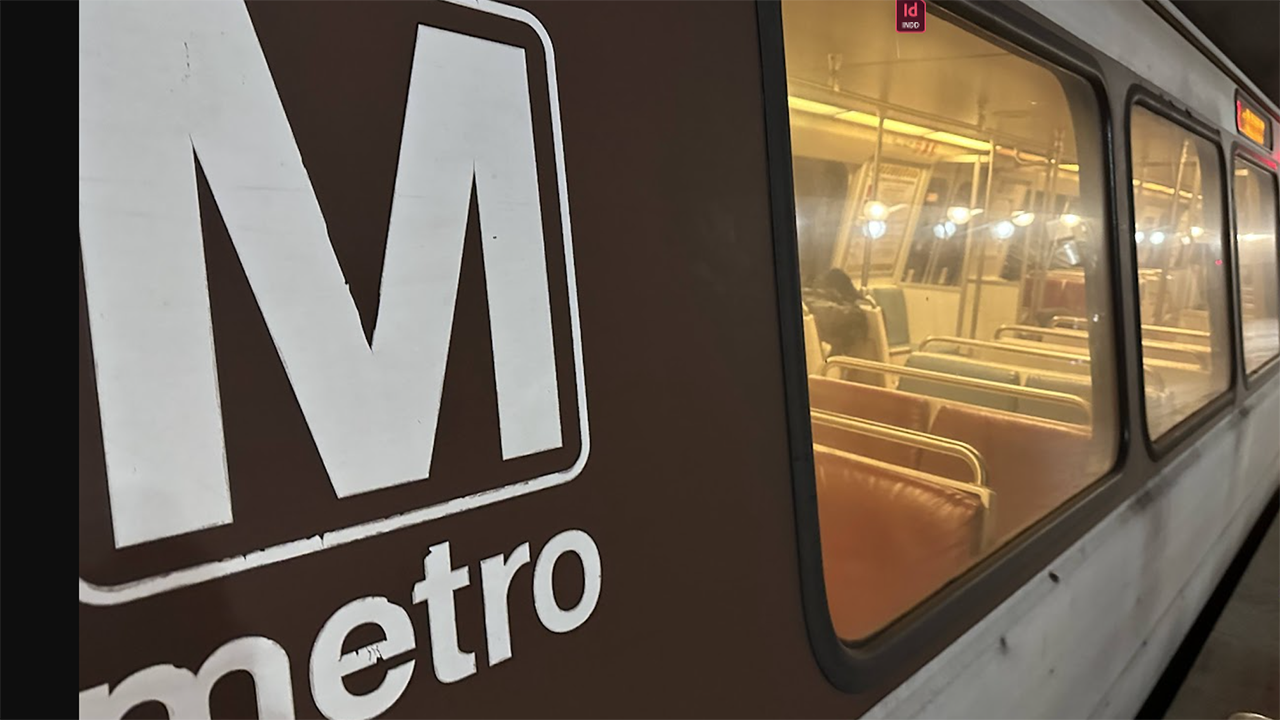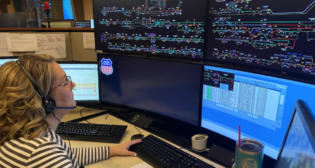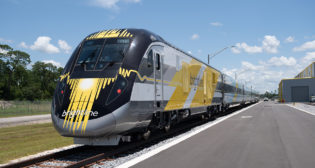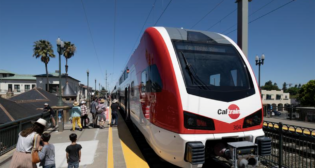
Transit Briefs: WMATA, SCVTA, Québec
Written by Marybeth Luczak, Executive Editor
The goal of removing from service WMATA’s aging 2000-series rapid transit cars is to leave “a more reliable fleet of newer vehicles” that will result in “fewer offloads and delays,” the agency reported May 9. (WMATA Photograph)
Washington Metropolitan Area Transportation Authority (WMATA) is officially retiring its 1980s-era equipment from Italian firm Breda (now Hitachi Rail Italy). Also, the 2024 federal budget allocates $500 million to Santa Clara Valley Transportation Authority’s (SCVTA) BART Silicon Valley Extension Project in California; a new public transit development agency is eyed for Québec; and more transit-oriented development (TOD) is planned for Montréal.
WMATA

WMATA on May 10 will officially retire its 2000-series trains, which have reached the end of their 40-year service life. The agency reported May 9 that its goal is “to remove the aging trains that have more maintenance issues, leaving a more reliable fleet of newer vehicles resulting in fewer offloads and delays.” The 2000-series, it noted, “had issues nearly four times as often as our newer [Kawasaki Rail Car USA-built] 7000-series trains.”
The 76 2000-series rapid transit cars, which were built by Breda in Italy (now Hitachi Rail Italy) and assembled in Beech Grove, Ind., debuted in 1983—about two years behind schedule due to a factory breakdown in West Germany and a labor strike in a Wilmerding, Pa., brake factory, according to WMATA.
They are said to have operated nearly 200 million miles and carried more than 775 million riders. According to WMATA, their introduction allowed the agency to offer service to Huntington and Fairfax County, Va.
While the 2000-series cars look similar to the 300 Rohr-built 1000-series cars that entered service in 1976 and were retired in 2016-17, WMATA said they included “new” features like flip-dot destination signs instead of mylar roll signs that often malfunctioned, exterior speakers for announcements, and a dozen fewer seats to allow more riders per train.
In the early 2000s, the 2000-series cars went through a mid-life rehabilitation, replacing propulsion systems, adding new exterior and interior LED signs, and updating the seats with a new color motif (Colonial Burgundy, Potomac Blue, and Chesapeake Sand), WMATA said.
The cars were largely in storage during the pandemic, but were used in recent years while the agency addressed issues with the other fleet series, it said. WMATA in 2021 began sidelining its 748 Kawasaki-built 7000-series cars due to a derailment, so it could develop a response to wheel gage anomalies and implement a plan for safely returning them to service. The 7000-series comprises roughly 60% of WMATA’s fleet.
In the coming months, the 2000-series cars will be decommissioned and their safety-sensitive parts and hazardous materials will be removed, according to WMATA. Two of the rapid transit cars will be saved for preservation and another two will be used as part of the agency’s “money train that collects cash from fare machines around the system.”
WMATA said its long-term fleet strategy calls for phasing out the 290 Breda-built 3000-series cars starting in 2027. At the same time, WMATA will begin introducing the first of its new 8000-series Fleet of the Future cars. The agency in 2021 awarded Hitachi a contract to design and build an initial order of 256 8000-series cars, which will replace aging 2000- and 3000-series cars. If all options in the contract are exercised, a total of 800 cars will be supplied to the agency, worth up to $2.2 billion. Hitachi will manufacture the car body structure, fit out the trains, and carry out final assembly at a new Washington area plant. Hitachi’s $70 million, 307,000-square-foot factory and 800-yard test track will be 90 minutes from WMATA’s Greenbelt Rail Yard, where the completed cars will be delivered.
The rest of the WMATA fleet will be made up of Alstom-built 6000-series cars (with the classic brown stripe motif), and newer 7000-series, and 8000-series cars.
Until the 8000-series cars arrive, WMATA said it will still have enough equipment to accommodate current peak ridership and up to 33% more ridership before sustained crowding.
WMATA retired the 100 Breda-built 4000-series cars in 2017 and the 192 CAF/AAI-built 5000-series in 2018 and 2019.
(In a related development, WMATA recently displayed a mock-up of its new 8000-series cars, plus one of its new 60-foot zero-emissions buses, at the Fleet of the Future Expo.)
Following is a photo gallery of WMATA’s 2000-series cars:










SCVTA
The Federal Transit Administration (FTA) on May 9 announced that $500 million is officially in the federal budget to be used toward a Full Funding Grant Agreement (FFGA) for the BART (San Francisco Bay Area Rapid Transit District) Silicon Valley Phase II Extension Project, according to SCVTA. SCVTA is the project’s funding agency and delivery manager, while BART will be the system operator and maintainer.
The allocation “is the first funding commitment for the project through the FTA’s New Starts Funding Program,” said SCVTA. The agency reported that it will submit its formal request for approximately $6 billion, roughly 50% of the project cost, through the FTA funding program later this summer with the expectation of completing the full funding agreement with the FTA before the end of the year. The FFGA will outline the terms, timeline and annual allocations VTA will receive. The other half of the project cost is already committed with local and state funds, which include the Transit and Intercity Rail Capital Program, Regional Measure 3, 2000 Measure A, and 2016 Measure B, according to SCVTA.
The estimated completion date has been adjusted from 2033 to 2036 based on updated engineering and risk assessments, according to SCVTA.

The six-mile extension project—which includes three underground stations (28th Street/Little Portugal, Downtown San José, and Diridon), one at-grade station (Santa Clara), a maintenance facility, and five miles of subway tunnel—will expand BART service from the Berryessa Transit Center in northeast San Jose through downtown San Jose into the city of Santa Clara (see map, above). The 10-mile BART Phase I Berryessa Extension Project opened in 2020; it begins south of BART’s Warm Springs Station in Fremont, proceeds through Milpitas and ends in the Berryessa area of north San Jose.
“SCVTA has worked cooperatively with the FTA to advance through the rigorous FTA funding process,” SCVTA General Manager and CEO Carolyn Gonot said. “This half-billion-dollar commitment demonstrates not only that we are on the right track, but also that we are in line with FTA guidelines and expectations. It’s great news.”
“It is a sign of incredible confidence that the FTA and the President of the United States are interested in this project,” SCVTA Board Chair and Santa Clara County Supervisor Cindy Chavez said. “This $500 million [investment] inches us closer to getting this project completed.”
Québec

The Québec Minister of Transport and Sustainable Mobility Geneviève Guilbault on May 9 tabled a bill instituting the “Mobilité Infra Québec, an agency for the development of public transit,” according to The Canadian Press report published by CTV News Montréal.
Mobilité Infra Québec would handle “opportunity analysis, planning and implementation of complex transportation projects,” the news outlet reported. “The minister said she wanted to regain control of the sector, adding that projects are being carried out too slowly, and they’re costing too much. Guilbault says her new agency aims to correct these problems.”
According to The Canadian Press, the bill specifies that the agency “will be able to ‘acquire, by expropriation, the properties it deems necessary to carry out its mission on its own behalf or on behalf of the government, a local municipality, a public transit corporation, the Réseau de transport métropolitain (REM) or the Autorité régionale de transport métropolitain (ARTM).’’
Additionally, a bill “to reform the way public contracts are awarded in order to reduce construction costs and times” was tabled concurrently by Québec Infrastructure Minister Jonatan Julien, The Canadian Press reported. “Under certain conditions, the bill will allow a public body to conclude a contract by mutual agreement after an unsuccessful call for tenders.”

Also on May 9, residential real estate development company Groupe HD and its partners property investment and management firm Kastello Immobilier and holding company Société Financière Bourgie reported the acquisition of the Fortier Ford commercial site, located at 7000 Boulevard Louis-H.-La Fontaine in the Montréal borough of Anjou, which they will reposition as a TOD comprising almost 1,000 residential units. The terminus of the Montréal metro’s blue line extension, currently under construction, is few than 273 yards (250 meters) away, “maximizing the site’s potential for development of a fully integrated living environment,” the partners said. “Quick access to public transit, green spaces, local retailers and other neighborhood services are significant project assets.”
This acquisition marks the start of a planning and development process.
“Kastello Immobilier is delighted to be teaming up with Groupe HD and Société Financière Bourgie and helping revitalize a district where demand is currently high,” said Mathieu Collette, Partner and Vice President, Real Estate at Kastello Immobilier. “With the coming opening of the Anjou metro station, residents will enjoy access to an efficient, environmentally friendly underground transit system connecting the borough of Anjou to downtown Montréal.”



